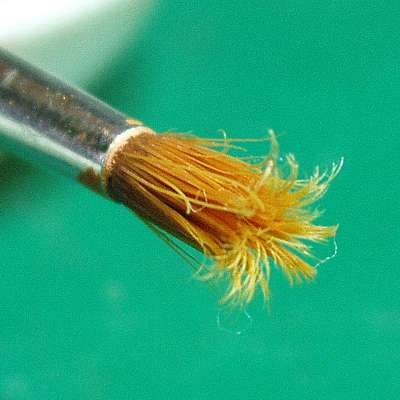Notes on the care of your brushes.
There are many containers on the market which are aimed at holding an artist’s brushes. Most, unfortunately are unsuitable, and soon end up spoiling the brushes rather than protecting them.
In the past tin tubes were produced. These black painted relics are often prized and sold for high prices in antique fairs but in use, they soon result in bent and broken hairs. So too, do the modern versions made of plastic as the brushes crash into the hard end of the container.
Fabric rolls and leather wallets have other effects on your brushes which are rarely put away dry. They tend to hold moisture and can result in mould growth, and even rust in the ferrules.
Brushes stored for travel need to be in a well aired container which holds them firmly and makes sure that the hairs or bristles do not suffer damage.
Luckily, a new and really inexpensive product has been available for some time now. It is the bamboo brush roll from China. This simple product holds large numbers of brushes which cannot move in transit. The hairs are kept straight and are allowed to dry out naturally as air passes freely though them. This keeps them free from mould.
When not in use, clean brushes should be shaped, (I must admit I suck mine into shape!) stored in an upright position. Brush pots are fine and drilled wooden blocks even better. They should be kept cool and away from radiators and sunny window sills.
If you are a water colourist, try to avoid dipping your brush so that the water goes beyond the ferrule as this can cause trouble with the wood which can all too often, distort causing the ferrule to become loose and break away. Dry your brush handles before storing them. Particular care should be taken when using Indian Ink, as this has the effect of drying out in the ferrule and causing corrosion and breakage.
New brushes are a delight and it is often frightening when a few hairs come out. This is quite natural with a new brush, but the amount should be very small and it should stop very quickly. If the moult continues, complain to the brush maker. This can be done through the shop where the brush was purchased. Most fine water colour brushes are supplied with a plastic sleeve for protection. Never try to reuse this protective sleeve. Throw it away. Then rinse away any gum which has been used to shape the brush. The brush will improve with use.
Watercolour brushes can be very expensive as the Red Sable, Kolinsky Sable and squirrel hair are expensive imports and good brushes are fashioned with great skill, by hand. They should always be well rinsed in running water to make sure no watercolour gum remains. Dry them with tissue before shaping them and stand them in an upright position. Acrylic and emulsion paints should be washed away before it dries completely. Washing up liquid is OK to use but remember to use a drop of hair conditioner on you brushes every once in a while. Let the brushes soak in conditioner before washing it away. This will keep the hairs in good condition for a long time.
Brushes used for oil painting can easily become clogged and I know of some artists who actually quite like painting with these stiff sticks. Most however, prefer to have brushes in their original condition, so always clean them in fresh white spirit before washing them in washing up liquid and water. Dry them after washing. Large oil painting brushes can be wrapped in kitchen tissue to keep their shape.
If you have bought brushes with fine tips it is not a good idea to mix colours with them. Buy some cheaper brushes and reserve them for mixing colours. This will save the fine tip of your best brushes from being worn away.
Always try to buy the best brushes you can find. There is no substitute for quality and a handmade brush in good hair will outlast and outperform cheaper brushes. There are lots to choose from and most are very poor quality.

Prevent splayed and damaged bristles by storing your brushes correctly.
A Bamboo Brush Roll is an effective and inexpensive way to store your brushes.